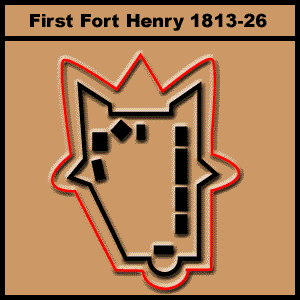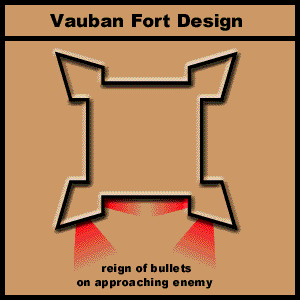
 Back to the Historical Background
Back to the Historical BackgroundIn preparation for the tactical defence of Canada, a commission was formed, to be headed by Sir James Carmichael Smyth. He recommended a budget of £1.6 million, including £220,000 for Kingston. A new fort for Point Henry was to cost £171,000.

However, because of this plan's fast-paced tempo and overexpenditure on the canal, London formed a new committee led by Major-General Sir Alexander Bryce and had a Canadian subcommittee chaired by Sir James Kempt, the commander-in-chief of British North America.
Instead of just a fortress, the Bryce commission proposed turning Kingston into a fortified city with defences on all fronts.
The new plan was based on a tactical theory which stipulated that to protect the dockyard, the harbours and the military stores from attacks and bombardments, it was necessary to keep the enemy off the high ground east and west of the Cataraqui River. Fort Henry was to become a "citadel" consisting of a large case-mated redoubt with flanking ditches and a sea battery with connecting bombproof commissariat stores (a REDOUBT was a fortification that could not cover its own flanks from its own parapets, but used the offensive power of its guns to cover its neighbours' flanks). The plan included more redoubts, towers and batteries. Towers were also to be constructed on the islands off Point Henry. The cost of the proposal was estimated at £273,000, or £53,000 more than Smyth had requested.
In order to understand the thoughts behind the commission's proposal, the fortification theory of the day must be examined. Most forts were built based upon the principles of the French engineer Vauban.

In this complex design of fortification, the besieger was forced to attack through a series of mutually supporting strong points arranged in great depths with mathematically precise interlocking fields of fire. Guns were sited on parapets to sweep the ditches through which the enemy must pass in the final stages of the attack. Thus, the enemy was herded like sheep into deathtraps between the strong-points. The enemy could get very near to the fort but would get mowed down very quickly. This fortification was more defensive by nature. Although successful at the time, it still allowed the enemy to get uncomfortably close. This was always a risk, so another fortification system was developed.

In the beginning of the nineteenth century, the Prussians made a simpler idea of fortification popular. This was called the modern or polygonal system. Instead of being just a defensive fortification, the design was now offensive in nature. It was based on the point blank range of the gun, which was roughly twice the maximum range of the musket. The fire power of these guns could keep the enemy at a further distance from the fort instead of drawing them into the interlocking fields of fire near the fort, which was the defensive theory behind the Vauban system. Strong points, which were vital to the Vauban forts, were now fewer in number. Depth was achieved by the positioning of concentric rings of small self-contained redoubts. Internal protection was reliant on reverse fire chambers and caponiers sited, hidden and protected in ditches. This was a cheaper design because redoubts were simple to build and only required a small garrison.
The military technology of weapons was not much more advanced than it was in the seventeenth century. The firepower of the soldier was still the flint lock musket with an effective range of less than 200 yards.
The fortification was therefore superior to the weapons of the day. The polygonal system of fortification could keep the besieger at arm's length by using the offensive power of its guns. If the attacker did manage to storm the fortress, they would be caught in a deathtrap between two protected lines of fire from a stone escarp and counterscarp.
 Go to The
Construction of Fort Henry
Go to The
Construction of Fort Henry
![]()